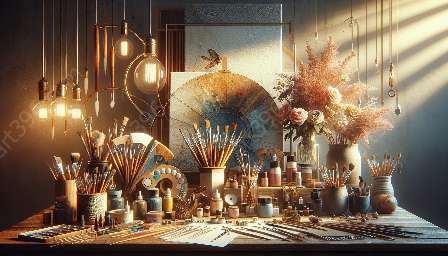Artistic expression is shaped and enhanced by the use of various art and craft supplies, each contributing to different art styles and techniques. Understanding the characteristics of popular art & craft supplies provides insight into their influence on the creative process. Let's delve into the fascinating world of art supplies and their significant roles in diverse artistic creations.
Characteristics of Popular Art & Craft Supplies
The characteristics of art & craft supplies play a crucial role in determining their impact on artistic styles and techniques. By examining the unique traits of popular supplies, artists can leverage their properties to achieve specific artistic outcomes. Some essential characteristics of popular art & craft supplies include:
- Color Range and Intensity: Pigments and dyes in supplies such as paints, markers, and pastels determine the color range and intensity, influencing the vibrancy and mood of artworks.
- Texture and Consistency: Various supplies offer diverse textures and consistencies, from smooth to gritty, fluid to opaque, enabling artists to create tactile and dimensional effects in their work.
- Opacity and Transparency: The level of opacity or transparency in supplies like inks and papers affects how light interacts with the artwork, influencing depth, layering, and visual impact.
- Drying Time and Workability: Different supplies have varying drying times and workability, impacting blending, layering, and the overall control artists have over their creations.
- Compatibility and Versatility: Some supplies are versatile and compatible with others, allowing artists to combine techniques and mediums to achieve unique effects and styles.
How Art & Craft Supplies Contribute to Diverse Art Styles and Techniques
The use of diverse art and craft supplies contributes significantly to the evolution and diversity of art styles and techniques. Here's a closer look at how different supplies shape artistic expression:
Paints and Pigments
Paints and pigments, such as acrylics, oils, watercolors, and gouache, offer a spectrum of colors, viscosities, and drying properties. These supplies enable artists to explore various painting styles, from realistic and detailed to abstract and expressive. Additionally, the use of different painting techniques, such as layering, glazing, and impasto, allows for the creation of rich, textured artworks.
Drawing and Illustration Tools
Pencils, pens, charcoal, and markers are essential for sketching, drawing, and illustration. Artists can experiment with line quality, shading, and mark-making, influencing the overall style and visual language of their artworks. The versatility of drawing tools also allows for the creation of intricate details or bold, expressive strokes.
Printmaking and Collage Materials
Materials such as printmaking inks, linocut blocks, and collage papers offer unique opportunities for artistic expression. Printmaking techniques, including relief, intaglio, and screen printing, contribute to the development of distinct styles, while collage materials allow for the combination of diverse visual elements to create layered, textured compositions.
Textiles and Fiber Arts Supplies
Fiber arts supplies, including yarn, fabric, and embroidery threads, provide artists with the means to create tactile and visually captivating artworks. Techniques such as weaving, embroidery, and quilting allow for the integration of texture, pattern, and color, leading to the development of diverse textile-based art styles.
Sculpting and Modeling Media
Clay, plaster, and sculpting tools enable artists to work in three-dimensional forms, exploring sculptural styles and techniques. The malleability and structural properties of these materials allow for the creation of figurative, abstract, and conceptual sculptures, each influenced by the specific characteristics of the chosen medium.
Mixed Media and Experimental Supplies
Artists often combine multiple art and craft supplies to create mixed media artworks. By integrating different materials such as found objects, textures, and unconventional media, artists can push the boundaries of traditional art styles, resulting in eclectic, experimental, and innovative creations.
Conclusion
The world of art and craft supplies is a vast and dynamic landscape that directly impacts the diversity of art styles and techniques. By understanding the characteristics of popular supplies and their unique contributions to the creative process, artists can elevate their artistic expressions and expand the boundaries of visual storytelling. Embracing the versatility and transformative potential of various supplies empowers artists to explore, innovate, and cultivate a rich tapestry of diverse art styles.

